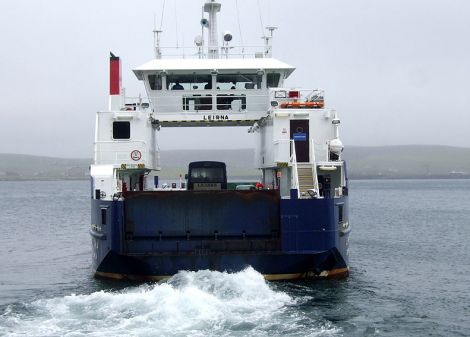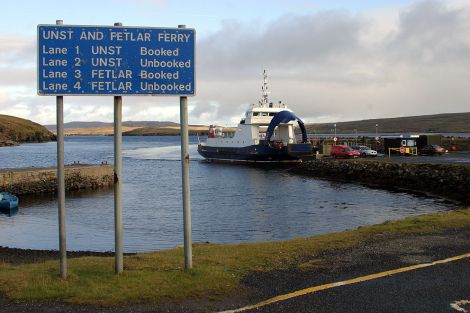News / Council wants Holyrood to deliver fairer ferry fares
ISLES politicians have vowed to press the Scottish Government to put in place fairer funding for inter-island ferries to reduce the financial burden on Shetland Islands Council.
The local authority currently receives around £6.5 million a year from Holyrood for ferry services, but spends £13 million a year.
Income from passenger and vehicle fares amounts to £1.94 million – leaving an annual shortfall of around £4.5 million for the council to cover.
Shetland MSP Tavish Scott said the SNP government had “repeatedly refused the logical case” to extend RET (road equivalent tariff) fares to inter-island ferries in the Northern Isles.
Scott added that he was “more than happy to work with the SIC to press the Scottish Government for more funds to support these lifeline services” – but he claimed ferry fares had been a “huge and surprising omission” from the Our Islands Our Future campaign, adding: “I fail to understand why it was not included.”
SIC leader Gary Robinson said Scott was “completely wrong if he thinks that”, saying the campaign had explicitly raised the “discrepancy” which sees Shetland and Orkney councils funding ferry services and infrastructure, while the Scottish Government “funds everything” in the Western Isles and on the west coast.
Robinson said the council will meet Transport Scotland to discuss the issue shortly. “They have given a commitment that they will look at a fair funding mechanism for ferries right across Scotland,” he said.
The subject cropped up at Monday’s meeting of the SIC environment and transport committee during a discussion of the ferry fares review being conducted by transport officials.
Committee chairman Michael Stout said the council was lobbying the SNP government to recognise that it contributed “a significant amount every year to providing the cost of ferry services”.
He was responding to a call from North Isles councillor Robert Henderson for fares to be removed on ferry routes in a similar way to how tolls have been abolished on bridges connecting parts of the Scottish mainland.
Become a member of Shetland News
“They took the tolls off the bridges of Scotland,” he said, “and we’re only asking for inter island ferries to be treated in the same manner. Wir ferries are wir bridges between land masses.”
Henderson said fares had “always been a bone of contention” in the North Isles, and he was also under the impression it had not formed part of the Our Islands Our Future campaign.
“I would certainly like to press strongly on them that that’s a route we should be going down to allow us to have the same fare structures as what commuters in the central belt of Scotland has.”
Some fares are likely to change from April 2015 once the current review is completed. Because the review has to be “cost neutral”, it is likely that some fares will increase while others will go down.
Transport chief Michael Craigie said one focus was looking to generate more income from visitors. In previous surveys, many tourists indicated they would be willing to pay higher fares to use Shetland’s inter-island ferries.
However, Craigie cautioned that charging tourists more would only result in a limited amount of extra revenue as it appears 90 per cent of fares are paid by islanders.
“We are generally looking at visitors more willing to pay higher fares… we’re also recognising they’re quite a small proportion of the overall travelling public.”
He said roughly half of ferry passengers were commuters or those on business, while most of the rest was made up of people visiting family and friends, leisure, shopping and attending medical appointments.
“We have to be mindful of the constraint that places on the opportunity to adjust fare levels,” Craigie said. “Early findings suggest it’s not going to be an entirely straightforward process.”
Stout said the perception following previous consultations was that “we could be effectively taking a lot more money off the tourists”, but the latest research showed “where our options are limited and will have knock-on consequences”.
Meanwhile Henderson decried what he views as slow progress on plans for fixed links to the Shetland mainland.
He was “horrified” to hear at a members’ seminar last week that it could be 15-20 years before a fixed link could be built. He referred to an industry figure in Norway who said a 5-6km-long tunnel to Whalsay could be finished in only four or five years.
“With the speed anything is moving at, everyone mixed up with the tunnel has to be wearing concrete boots,” Henderson said. “Are we any further ahead than we were seven years ago? I very much doubt it.”
Stout, however, said councillors had been informed that “the people who are building the fastest tunnels in the world are taking around 15 years on average from point of decision to point of completion.”
He believed some progress had been made in the past six months and says there has not been “any reduction in enthusiasm or appetite for fixed links”.
Become a member of Shetland News
Shetland News is asking its readers to consider paying for membership to get additional perks:
- Removal of third-party ads;
- Bookmark posts to read later;
- Exclusive curated weekly newsletter;
- Hide membership messages;
- Comments open for discussion.
If you appreciate what we do and feel strongly about impartial local journalism, then please become a member of Shetland News by either making a single payment, or setting up a monthly, quarterly or yearly subscription.






























































